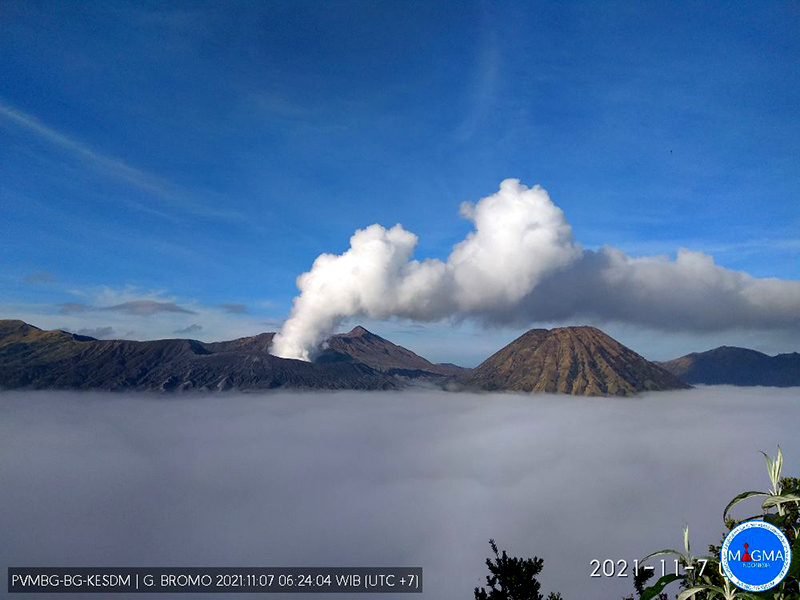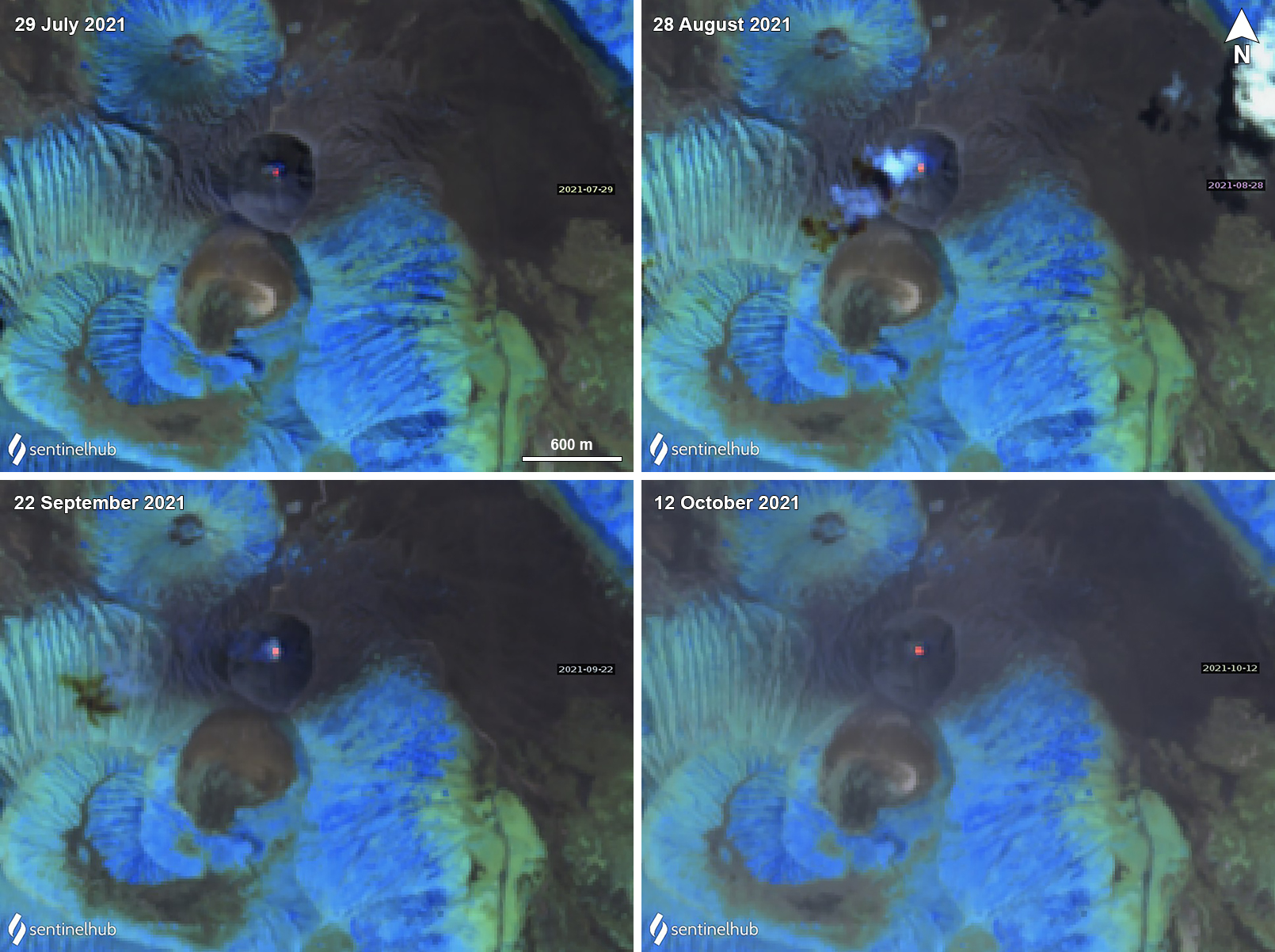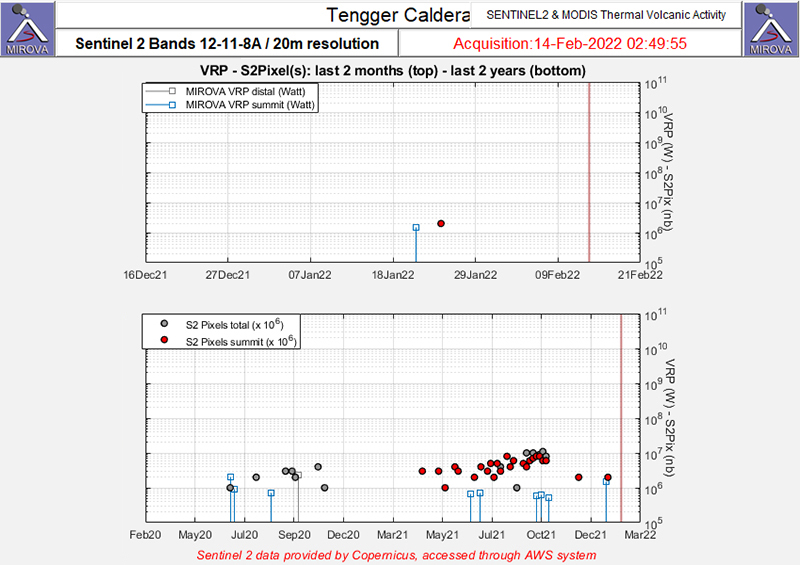Report on Tengger Caldera (Indonesia) — January 2022
Bulletin of the Global Volcanism Network, vol. 47, no. 1 (January 2022)
Managing Editor: Benjamin Andrews.
Edited by Kadie L. Bennis.
Tengger Caldera (Indonesia) Gas-and-steam emissions and a weak thermal anomaly at Bromo during July-December 2021
Please cite this report as:
Global Volcanism Program, 2022. Report on Tengger Caldera (Indonesia) (Bennis, K.L., and Andrews, B., eds.). Bulletin of the Global Volcanism Network, 47:1. Smithsonian Institution. https://doi.org/10.5479/si.GVP.BGVN202201-263310
Tengger Caldera
Indonesia
7.942°S, 112.95°E; summit elev. 2329 m
All times are local (unless otherwise noted)
Tengger Caldera, located at the N end of a volcanic massif in East Java, consists of five overlapping stratovolcanoes that are truncated by a caldera. An overlapping cluster of post-caldera cones was constructed on the floor of the Sandsea caldera within the last several thousand years, the youngest of which is Bromo, the only currently active cone in the 16-km-wide caldera. Its most recent eruption period occurred during April 2021 and mostly consisted of white-to-gray gas-and-steam emissions and a weak thermal anomaly in the Bromo crater (BGVN 46:07). This report covers continued low-level activity consisting of white-to-gray gas-and-steam emissions, with information provided by the Pusat Vulkanologi dan Mitigasi Bencana Geologi (PVMBG, also known as Indonesian Center for Volcanology and Geological Hazard Mitigation, CVGHM) and satellite imagery.
Activity was relatively low during July through December 2021 and was primarily characterized by white-and-gray gas-and-steam emissions that rose 50-600 m above the summit (figure 21). Weather conditions often obscured views of the volcano. Intermittent deep volcanic earthquakes were also reported. A persistent weak thermal anomaly was identified in the Bromo crater, on clear weather days in Sentinel-2 infrared satellite imagery (figure 22). According to MIROVA (Middle InfraRed Observation of Volcanic Activity) data, a gradual increase in the number and frequency of thermal pixels was detected from April through October (figure 23). On 3 and 5 October and 4, 25, and 31 December a light sulfur smell was reported by the Bromo Observation Post (2.5 km from the volcano).
 |
Figure 21. Webcam image of Tengger Caldera’s Bromo cone emitting a white gas-and-steam plume on 7 November 2021. The cone to the right is Batok. Courtesy of MAGMA Indonesia. |
Geological Summary. The 16-km-wide Tengger caldera is located at the northern end of a volcanic massif extending from Semeru volcano. The massive volcanic complex dates back to about 820,000 years ago and consists of five overlapping stratovolcanoes, each truncated by a caldera. Lava domes, pyroclastic cones, and a maar occupy the flanks of the massif. The Ngadisari caldera at the NE end of the complex formed about 150,000 years ago and is now drained through the Sapikerep valley. The most recent of the calderas is the 9 x 10 km wide Sandsea caldera at the SW end of the complex, which formed incrementally during the late Pleistocene and early Holocene. An overlapping cluster of post-caldera cones was constructed on the floor of the Sandsea caldera within the past several thousand years. The youngest of these is Bromo, one of Java's most active and most frequently visited volcanoes.
Information Contacts: Pusat Vulkanologi dan Mitigasi Bencana Geologi (PVMBG, also known as Indonesian Center for Volcanology and Geological Hazard Mitigation, CVGHM), Jalan Diponegoro 57, Bandung 40122, Indonesia (URL: http://www.vsi.esdm.go.id/); MAGMA Indonesia, Kementerian Energi dan Sumber Daya Mineral (URL: https://magma.esdm.go.id/v1); MIROVA (Middle InfraRed Observation of Volcanic Activity), a collaborative project between the Universities of Turin and Florence (Italy) supported by the Centre for Volcanic Risk of the Italian Civil Protection Department (URL: http://www.mirovaweb.it/); Sentinel Hub Playground (URL: https://www.sentinel-hub.com/explore/sentinel-playground).



